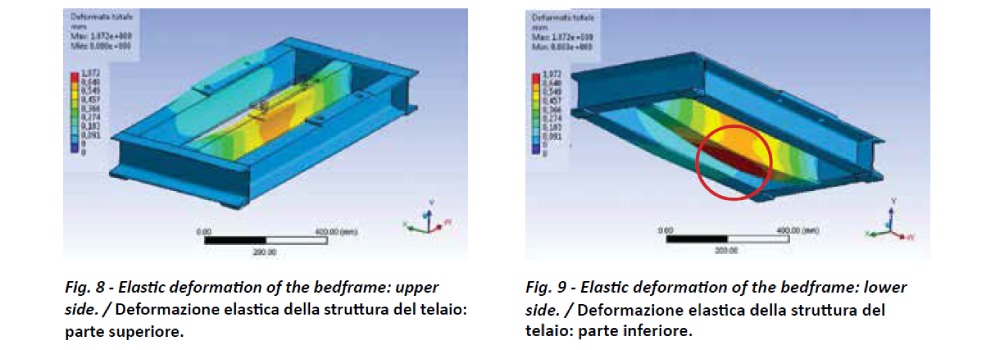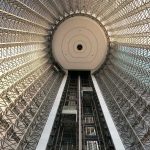Montanari: Frame design and lift safety
The frame is often an integral part of lifting systems and its correct choice is crucial for lift safety. What information is needed? What to pay attention to? What are the risks? How to choose correctly?

Let’s start with its function: to support the traction machine and the load of the whole system.
It may appear simple: a few steel beams welded and bolted together.
The choice and design of the right frame is essential for the correct support of the machine in relation to the weight and torque generated by the mechanical movement. In case of lack of attention in this step, the consequences could prove fatal.
To choose the bedplate (another name for the frame), we start with the data of the lifting system and the reference standard. At Montanari we have special editable forms that guide users to the correct compilation. The next step is the execution of tests with FEM calculation software:
• Equivalent tensile stress
• Elastic deformation
• Safety Factor
We examine these steps with a simulation that demonstrates how even changes of only a few mm can have significant effects on the final result. The simulation was used for an internal training in the technical department (Montanari Academy [1]) based on real projects.
Let us assume that the data are those in Tables 1 – 2 – 3 and the design that in Fig. 3 – 4. We test how the material will react to the assumed loads applied to the machine.


What happens in the simulation?
The system reproduces the effect of weight and torque (Fig. 5 – 6) in the following way:
– the static vertical load is applied to the slow shaft;
– torque is applied to the traction sheave that lifts the counterweight (CWT).
It is then verified whether the model is able to withstand the given load using FEM tests.

TEST: EQUIVALENT TENSILE STRESS
Stress method: Von Mises [2]. Due to the acceleration and inertia of the system, the load and torque applied to the machine are multiplied by a factor of 2.
According to good practice, the maximum permissible stress on this hypothetical frame is 1/3 of the yield stress.
Simulating this situation on the frame structure, we obtain the result in Fig. 7.
What can be deduced?
There are different coloured areas. The red ones are not permissible. The frame may appear to be solid, but the simulation informs us that it does not conform to the system features. Without the test, this won’t be detected.

TEST: ELASTIC DEFORMATION
According to good practice, the maximum permissible deformation on the frame structure must be 1/1500 of the maximum length: 960 mm/1500 = 0.64 mm (960 is the length of the beam). The red coloured area on the representation is not permissible: the total deformation is up to 1.8mm (Fig. 8 / 9).

TEST: SAFETY FACTOR
The minimum safety factor is 3: there are areas where this factor is not met. A force exceeding the yield stress applied to a structure can lead to permanent deformation (Fig. 10).
What would happen in the real situation?
Permanent deformation of the frame due to incorrect design can lead to the failure of the entire frame, which is no longer able to support all the load.
A further consequence could be that the machine would come off its seat with high risks for the whole system.
Taking into account the system features and the traction machine, what would be a suitable solution?
Based on the calculations, we slightly vary the height of the frame beam: compared to Table 2, the value increases from 125 to 175 mm. The effect of weight and force can be seen in Fig. 11 – 12.

Maximum permissible deformation on the frame: 1/1500 of the maximum length, according to good practice: 960mm/1500 = 0.64mm. The total deformation on the frame is 0.2 mm, so it is suitable for installation according to safety parameters.

Conclusions
An undersized frame can compromise the safety of the entire lift due to the high risk of breakage. It is advisable to always involve the machine manufacturer to verify the design and confirm the safety factor (even when the frame is not purchased from the machine supplier).
A preliminary study is always carried out at Montanari. In fact, sometimes the chosen frame may even be overestimated compared to system needs, and this entails a higher cost, considering the high price of raw materials.
NOTES
[1] Montanari Academy was inaugurated in 2017 at Asansor – Istanbul. Since then, all courses organised for customers and employees, in all Montanari branches, are delivered under the name Academy to better identify the value of this important service.ù
[2] Richard von Mises: was an Austrian naturalised US mathematician, engineer and academic. In solid mechanics, he developed the notion of the distortion energy associated with each tensional state, which is one of the most important concepts used in engineering when calculating the tensile stress of materials. He also made important contributions to plasticity theory by formulating what became known as the von Mises Criterion.








